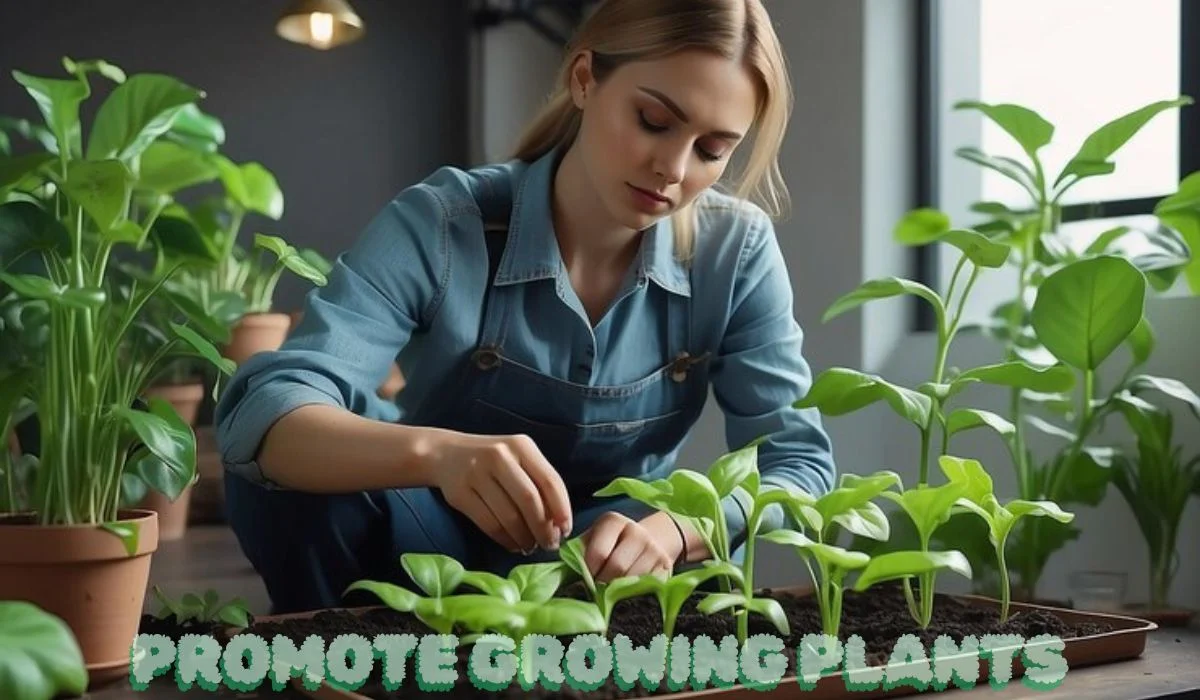Gardening has long been a rewarding hobby for many, but the key to achieving a flourishing garden lies in knowing how to promote growing plants effectively. Whether you’re an experienced gardener or just starting, understanding the right techniques to encourage plant growth will transform your garden into a lush and productive space. In this comprehensive guide, we’ll explore essential tips and best practices to ensure your plants thrive and remain healthy throughout their growth cycle.
By following these strategies, you’ll not only promote plant growth but also enjoy a beautiful garden that adds value to your home and the environment. Let’s dive into the different aspects of promoting healthy plant growth.
Understanding Plant Growth: What Makes Plants Thrive?
Before we get into the specifics of promoting growing plants, it’s important to understand the fundamental needs of plants. Like all living organisms, plants require certain conditions to grow and develop optimally. The six essential factors that influence plant growth are:
- Light
- Water
- Nutrients
- Air
- Soil
- Temperature
Each of these factors plays a critical role in a plant’s health. To promote growth, it’s necessary to strike the right balance among these elements.
The Role of Light in Plant Growth
Plants rely on light for photosynthesis, the process by which they convert light energy into chemical energy, which fuels their growth. The type of light, its intensity, and the duration of exposure all impact how effectively plants can photosynthesize.
To promote plant growth, make sure your plants receive an adequate amount of sunlight. Most plants require 6 to 8 hours of sunlight per day. For indoor gardening, consider using grow lights to ensure that your plants get the full spectrum of light they need.
Importance of Water and Proper Irrigation
Water is vital for plant health, and proper irrigation is essential in promoting plant growth. Too much or too little water can lead to root rot or dehydration, which stunts growth or kills the plant.
The best way to water plants is by ensuring the soil stays moist but not waterlogged. The frequency of watering depends on the plant species, weather, and soil type. For instance, succulents require less frequent watering than vegetables or flowers. Drip irrigation systems are a great way to provide water directly to plant roots without over-saturating the soil.
Nutrients: Feeding Plants for Optimal Growth
Fertilization is key to promote growing plants effectively. Plants require nutrients to grow, and the three most important nutrients are nitrogen (N), phosphorus (P), and potassium (K). Each serves a different purpose:
- Nitrogen promotes leaf growth and is crucial for photosynthesis.
- Phosphorus supports root development and flowering.
- Potassium enhances overall plant health and resilience.
By providing plants with a balanced fertilizer that includes these nutrients, you can support their growth and development. Organic options like compost and manure can enrich the soil naturally while providing essential nutrients.
Promoting Growing Plants Through Soil Health
Soil Composition: The Foundation of Healthy Growth
The type and quality of soil significantly affect plant growth. Plants require well-draining, nutrient-rich soil to thrive. Soil composition refers to the balance between sand, silt, and clay. Each has different properties:
- Sandy soil drains quickly but holds fewer nutrients.
- Clay soil retains water but may become compacted.
- Loamy soil is ideal for most plants, offering good drainage and nutrient retention.
To improve soil health, consider adding organic matter such as compost or mulch. This will help maintain soil moisture, improve aeration, and provide necessary nutrients to promote growing plants.
You Might Also Like: Fibra : Pioneering Sustainable Fibre Crops for a Greener Future
Managing Soil pH
Soil pH refers to the level of acidity or alkalinity in the soil. Different plants require different pH levels for optimal growth. For example, most vegetables prefer a slightly acidic to neutral pH range between 6.0 and 7.0. To promote growing plants, regularly test your soil’s pH and adjust as needed. You can lower soil pH by adding sulfur or raise it with lime.
Techniques to Promote Growing Plants
Mulching to Improve Growth Conditions
Mulching is a simple yet effective method to promote plant growth by protecting soil and retaining moisture. Organic mulches such as wood chips, straw, or leaves decompose over time, adding nutrients back into the soil. Mulch also helps regulate soil temperature, suppress weeds, and prevent soil erosion.
For best results, apply a 2-3 inch layer of mulch around the base of plants, making sure to leave space around the stem to prevent rot.
Pruning and Trimming for Healthier Plants
Pruning and trimming are essential techniques that promote growing plants by removing dead or overgrown branches. Regular pruning encourages healthy growth, improves air circulation, and prevents disease by allowing sunlight to penetrate the plant more effectively.
Each plant species may require different pruning methods. For example:
- Fruit trees benefit from winter pruning to promote strong growth in the spring.
- Flowering shrubs like roses thrive when pruned right after blooming.
By staying on top of pruning, you ensure that your plants grow vigorously and maintain their desired shape.
Companion Planting to Promote Growth Naturally
Companion planting is an eco-friendly gardening practice that involves growing certain plants together to benefit each other. By combining specific plants, you can enhance growth, deter pests, and improve soil fertility. For example:
- Tomatoes and basil grow well together as basil repels insects that typically harm tomato plants.
- Beans and corn are great companions, with beans fixing nitrogen in the soil, which promotes corn growth.
Understanding which plants work well together will help you create a garden where all species support one another.
Promoting Growing Plants Indoors: Strategies for Success
Indoor gardening offers a unique set of challenges, but it also provides more control over growing conditions. To successfully promote growing plants indoors, focus on these essential factors:
Choosing the Right Containers
For indoor gardening, container choice matters. Ensure your containers have proper drainage holes to prevent waterlogged roots. The size of the container is also important—plants need enough room for root expansion. Larger plants like tomatoes may require deep containers, while herbs like parsley or basil can thrive in smaller pots.
Proper Lighting for Indoor Growth
Since indoor plants often lack direct sunlight, it’s important to use grow lights that mimic the sun’s full spectrum. LED grow lights are a popular choice because they are energy-efficient and provide the necessary wavelengths for photosynthesis.
Adjust the lighting depending on the growth stage of your plants:
- Seedlings need 16-18 hours of light daily.
- Mature plants thrive with 12-14 hours of light per day.
Humidity and Temperature Control
Indoor plants often require specific humidity and temperature conditions to thrive. Using a humidifier can help maintain the ideal moisture levels, especially during dry months. Most houseplants prefer temperatures between 65-75°F, though tropical plants may need a slightly warmer environment.
Common Problems and Solutions for Promoting Growing Plants
Even with the best care, plants may encounter issues that slow growth. Here are some common problems and solutions to keep your plants healthy and growing strong:
Overwatering or Underwatering
Watering is often the most misunderstood aspect of plant care. Overwatering can lead to root rot, while underwatering causes dehydration and wilting. To avoid these problems, always check the soil moisture before watering. Stick your finger about an inch into the soil—if it feels dry, it’s time to water.
Nutrient Deficiencies
Yellowing leaves, stunted growth, and poor flowering are often signs of nutrient deficiencies. Use a soil test kit to determine if your soil lacks essential nutrients. Based on the results, amend the soil with the appropriate fertilizers to provide the necessary nitrogen, phosphorus, or potassium.
Pests and Diseases
Pests and diseases can quickly affect plant health. Aphids, spider mites, and fungal infections are common culprits in both indoor and outdoor gardens. Using natural remedies such as neem oil or introducing beneficial insects like ladybugs can help manage pests without resorting to harsh chemicals.
Promoting Growing Plants Sustainably
Organic Gardening
One of the best ways to promote growing plants is through organic gardening methods. By avoiding synthetic chemicals, you create a healthier environment for your plants and reduce the ecological impact of your garden. Use organic fertilizers, natural pest control methods, and compost to enrich your garden sustainably.
Water Conservation
Water is a finite resource, and conserving it is crucial in promoting plant growth sustainably. Rainwater harvesting is an effective way to reduce water usage while ensuring your plants have access to water when they need it. Additionally, choosing drought-tolerant plants and using mulch can help retain soil moisture and minimize water waste.
Conclusion
Promoting the growth of healthy, thriving plants is an achievable goal for gardeners of all skill levels. By understanding and addressing the fundamental needs of plants—such as proper light, water, and nutrients—you can create an environment that supports robust growth. In addition, utilizing techniques like mulching, pruning, and companion planting will help ensure your garden remains productive and resilient.
Whether you’re growing plants indoors or outdoors, following these guidelines will set you on the path to success. Remember, a thriving garden not only adds beauty and value to your surroundings but also contributes to a healthier and more sustainable world.
By implementing these practices, you’ll effectively promote growing plants, resulting in a lush, vibrant garden that you can be proud of year-round.




